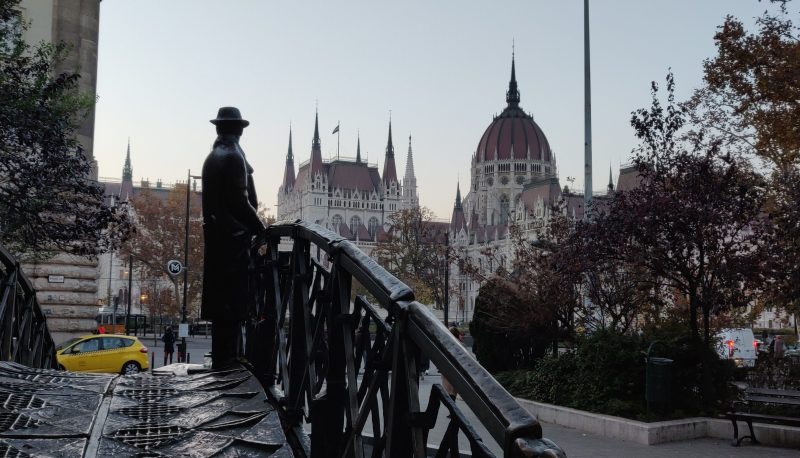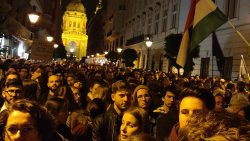In the middle of a July night in 2014, a new public memorial to the victims of German occupation was unveiled in Hungary’s capital city of Budapest. Four years later, in the dead of a December night in 2018, a statue of a beloved Hungarian hero was removed from its longtime home just yards away. The clandestine construction of new memorials and the removal of others are not isolated incidents. In recent years, Hungary’s right-wing leadership, under Viktor Orbán, has used memorials, along with restrictions on the press and academia, in a full-scale campaign to legitimize their rule—and that begins with reconstructing Hungary’s past.
Since becoming prime minister for the second time in 2010, Orbán and his Fidesz party have centralized power by censoring media companies, attacking the judiciary, and fanning the flames of xenophobia and nationalism. To hold onto power, the Orbán-regime has put forth a new narrative that suggests a strong history of conservative, nationalist authoritarianism in Hungary. This image is being used to strengthen not only Orbán’s own image, but also relations with Hungary’s Eastern neighbor, Russia.
A prime example of this manipulation of memory is Budapest’s Szabadság Tér, the “Freedom Square.” The square lies between the Hungarian Parliament and St. Stephen’s Basilica, the nation’s most important church, and is surrounded by embassies, government buildings, restaurants, and shops. It is also home to several monuments. In recent years, this square has served as a stage on which Hungary’s right-wing government has tried to control national narratives surrounding Hungary’s participation in the Holocaust, the Cold War, and Hungary’s 1956 Revolution.
Entering the square from the southwest corner, one of the first—and perhaps most problematic—of these statues is a 2013 bust of Miklós Horthy, Hungary’s prime minister for much of the interwar period and World War II. Horthy famously aligned the country with Germany and the Axis powers at the beginning of World War II.
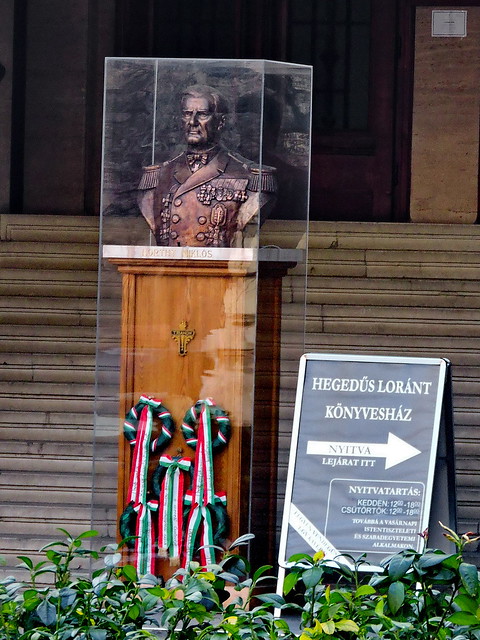
Under Horthy’s leadership in the 1930s, Hungary enacted some of the strictest anti-Semtic laws in Europe. While Horthy’s opposition to the deportation of Hungarian Jews is an oft-recited refrain by those on the right, such opposition didn’t stop the 1941 deportations of all Jews without Hungarian citizenship residing in Hungary to Nazi-controlled Ukraine, where the vast majority were massacred by the SS. By 1944, Hungary’s national Jewish population remained mostly intact, but Hungary’s continued alliance with the Nazis proved fatal. When Germany moved to remove Horthy in 1944, Horthy, still in place as the head of state, signed off on the naming of his Nazi-approved successor as prime minister, Döme Sztójay. Sztójay promptly began the deportation of Hungary’s Jewish population, sending close to 440,000 people to Nazi concentration camps, including Auschwitz and Bergen-Belsen.
Horthy’s role in the Holocaust made the 2013 erection of his statue at Szabadság Tér a cause for public outcry from both Hungarian and international organizations. The statue was commissioned by the Hungarian Reformed Church and is located on its stairs. The church has a long history of association with nationalist, far-right groups, including, the Arrow Cross Party of the 1930s and 1940s and Jobbik, the nation’s contemporary far-right parliamentary party. The current government of Hungary, under the control of the Fidesz party of Orbán, has done nothing to condemn the erection of the Horthy statue, instead choosing to ignore the erection of the statue due to its location on private property. Yet, despite the controversial and divisive opinions surrounding Horthy as a historical figure, current Prime Minister Orbán referred to Horthy as an “exceptional statesman” in a 2017 speech, prompting several statements of condemnation by human rights organizations, including the United States Holocaust Memorial Museum, which described Horthy in its statement as “a self-declared, life-long antisemite” and “Christian nationalist.”
The controversial Miklós Horthy statue is just the first of several controversial symbols around Freedom Square. Only a few meters east of the Hungarian Reform Church is Hungary’s divisive Memorial for Victims of the German Occupation. The memorial, erected in the middle of the night in July 2014, features the unsuspecting and innocent Archangel Gabriel, a common symbol for the nation of Hungary, while an imperial eagle, a metaphorical representation of Nazi Germany, menacingly swoops in from above. Below the sculpture, the words “In memory of the victims” are inscribed in stone.
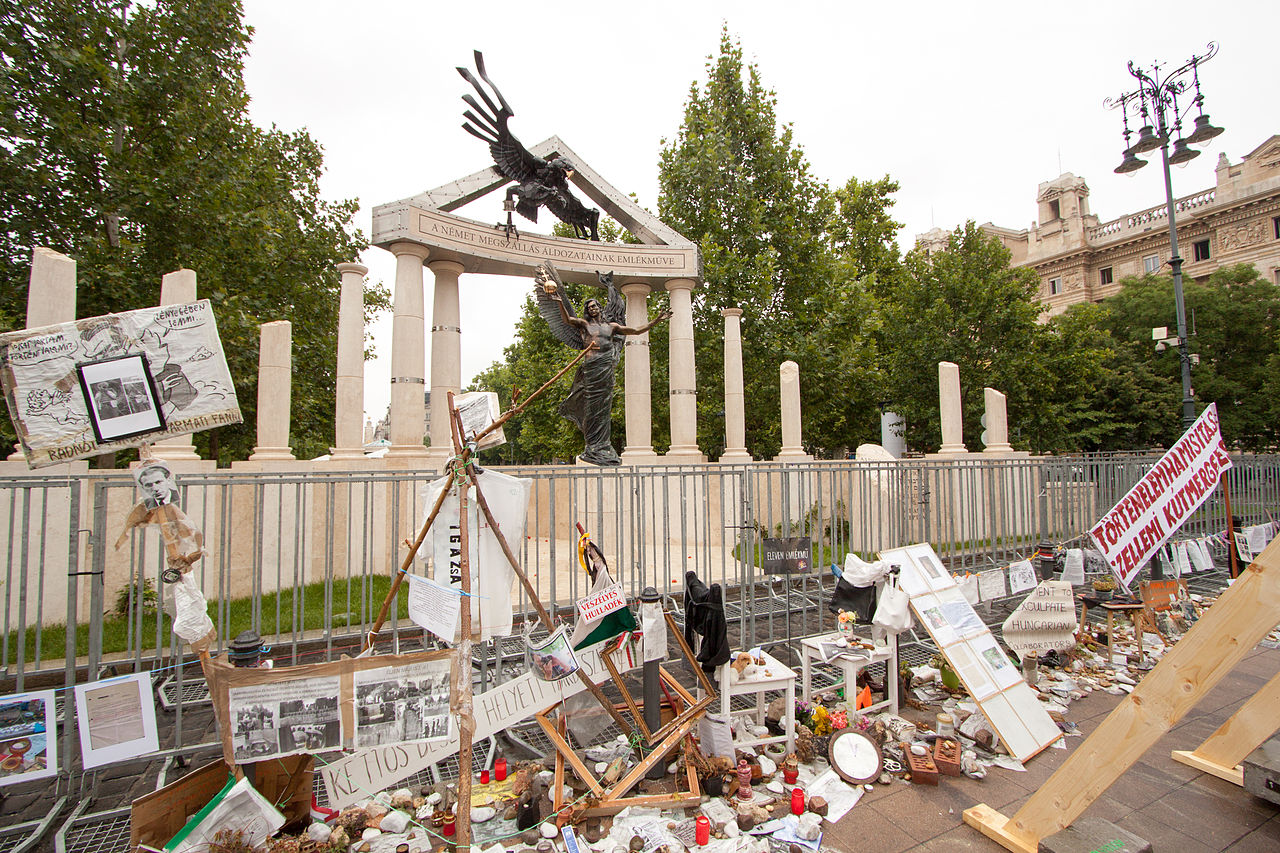
The memorial is commonly critiqued for the erasure of Jewish and Roma victims of the Holocaust, as well as Hungary’s role in the Holocaust. David Tucker, a Jewish activist and member of Hungary’s opposition Socialist party, described the memorial as “a lie.”
The story told by the monument is revisionist history—one in which the genocide of Hungary’s Jews and Roma is laid solely at the feet of Nazi Germany. This narrative, however, ignores the wartime Hungarian government’s complicity, its responsibility for Nazi occupation, and the crimes it committed against its minority populations.
These statues and memorials do not exist in a vacuum. When viewed in conjunction with Orbán’s praise for Horthy and the absence of his disapproval of the Horthy statue, the narrative perpetuated by the Memorial for Victims of the German Occupation becomes even more problematic. It allows Hungarians to avoid confronting Hungary’s history of anti-Semitism and the anti-Semitism in their country’s current political discourse.
Orbán has positioned Hungary as the “defender of Christian Europe” to advance his political agenda and his standing both in the European Union and at home. The strain of Christian-nationalism propagated in Hungary commonly uses both anti-Islamic and anti-Semitic tropes to position non-European “others” as a threat to the Hungarian nation.
Among Hungarians, these reconstructed, politically convenient narratives are not universally accepted. In protest, an unofficial monument was installed by the Hungarian activist group Eleven Emlékmű, or “Living Memorial,” in front of the official Memorial for Victims of the German Occupation.
This protest memorial includes laminated posters hanging from barbed wire. The posters are in different languages, some telling the stories of those Hungarian Jews sent to ghettos and concentration camps and others displaying newspaper clippings about the treatment of Jews in both the interwar period and during Hungary’s alliance with the Nazis. Additionally, the posters also address the revisionist nature of the monument, pointing out the ways in which the Hungarian government is trying to rewrite history through the creation of this statue. Underneath the hanging posters are candles and piles of stones, representing the Jewish tradition of leaving stones on graves. A chair is placed in front of this unofficial memorial both to signify those who lost their lives during the Holocaust and the willingness of those organizing this protest to create a dialogue with the viewer. Four years after its creation, the organizers of this living memorial have said that there are no plans to close it. Every time it is cleared away by municipal authorities or more frequently by far-right extremists, volunteers reconstruct it.
On the northern end of Freedom Square there are two more public monuments, showing the conflicting political narratives of a different dark time in Hungary’s history: the Cold War, when Hungary was dominated by the Soviet Union as part of the Eastern Bloc. The first of these is the Monument to the Soviet Red Army, the only Soviet monument which remains in the city center of Budapest. A large obelisk with a five-pointed Soviet-style star at the top, it commemorates the Soviet liberation of Budapest from the Nazis at the end of the Second World War. The monument is located atop the graves of Soviet soldiers from World War II and, because of this, is protected by a treaty between Russia and Hungary. The second monument, erected in 2011, lionizes the late U. S. President Ronald Reagan, who is often credited in part with the Soviet Union’s demise.
After the fall of communism in Central and Eastern Europe, the Monument to the Soviet Red Army was repeatedly vandalized while others occasionally called for its removal. The government of Hungary spent significant time reinventing Hungary’s national identity after the Cold War, when the dissolution of the Soviet Union relieved Hungary of rule by Soviet-aligned communist leaders. A 1993 decision to remove all Soviet monuments from Budapest city center is credited with helping to rebuild the Hungarian national identity.
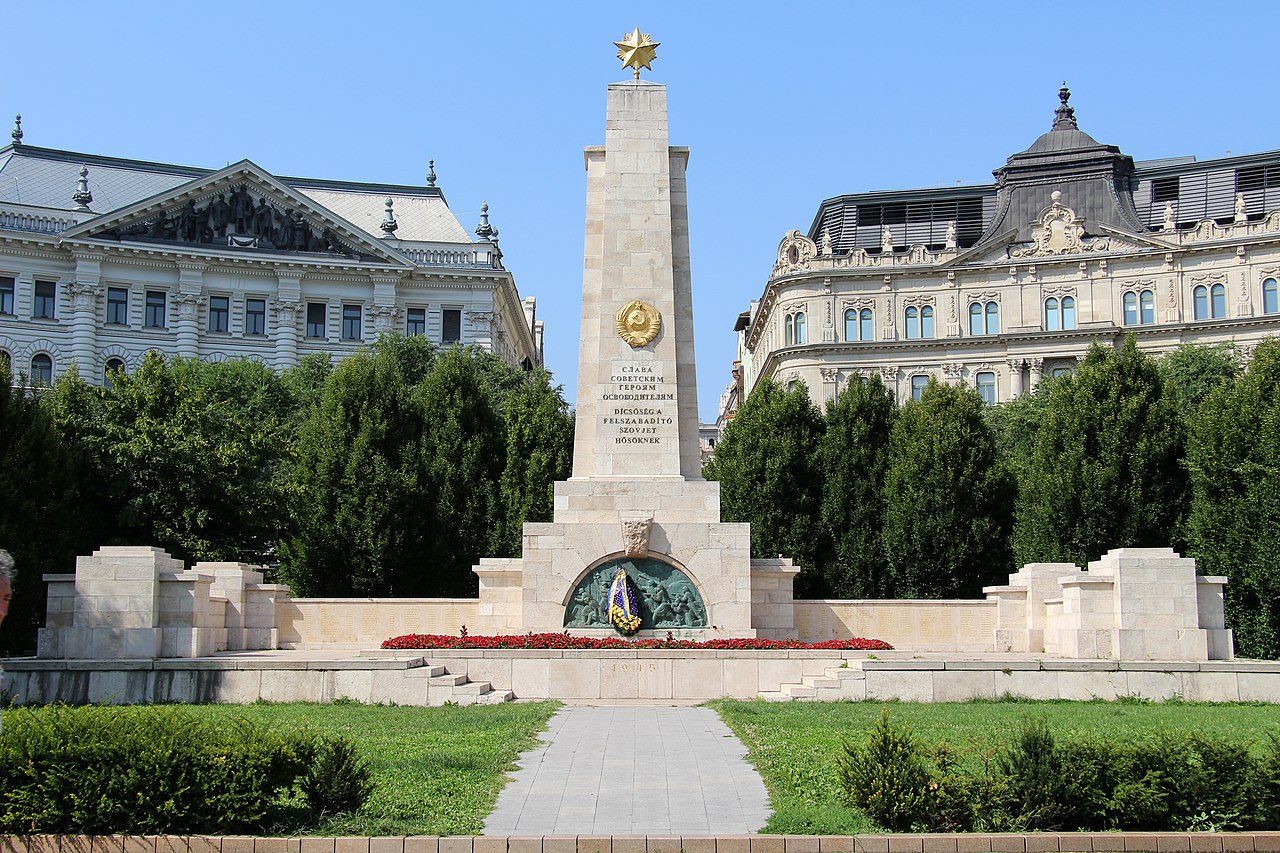
The removal of the statues throughout Budapest helped to symbolize Hungary’s liberation and newfound freedom to become a democratic nation. The calls from the Hungarian people to remove these monuments of Soviet power echo those by some Americans as they attempt to remove symbols of the Confederacy from public lands and buildings in the United States. The goal in both instances is to reaffirm a national identity free from historical oppression, such as slavery in the U.S. or Soviet communism in Hungary.
The removal of these statues throughout Budapest (save the treaty-protected monument to the Red Army), however, did not mean their destruction, but rather their relocation. Hungary’s Memento Park lies just outside of Budapest and is home to majority of Hungary’s Soviet monuments.
Yet, in their quest to construct a Hungarian national identity, Hungary’s leaders feared less the ire of its citizens than the possibility of upsetting Russia. The risk was especially palpable in 2007 after Russia placed informal sanctions on Estonia after the removal of the Bronze Soldier of Tallinn. Rather than destroy many of the Soviet-era monuments, Hungary relocated them to Memento Park, which lies just outside of Budapest. To defuse calls for the removal of the treaty-protected Red Army monument from anti-Soviet protesters, Hungarian officials decided to add yet another statue to the Freedom Square.
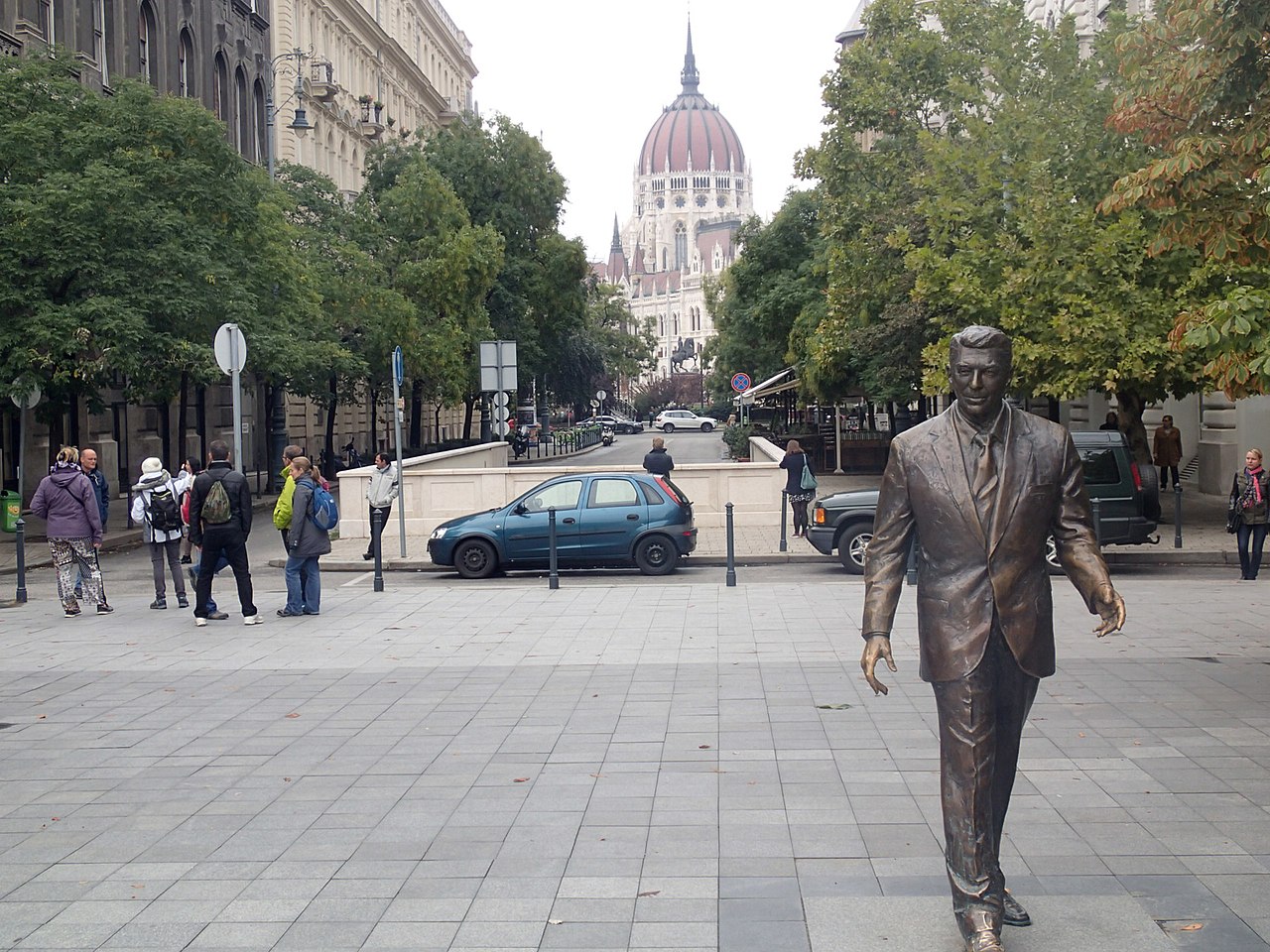
In 2011, a statue of Ronald Reagan, a popular figure in Hungary for his role in bringing the Cold War to a close, was unveiled in the northwestern edge of the square. The statue depicts Reagan mid-step, walking boldly through the square towards the American Embassy. The Monument to the Soviet Red Army and the Reagan statue demonstrate in a very tangible way the complexities of Hungary’s past and its current relationships with Russia and the West.
Although the Reagan statue did somewhat calm tensions with anti-Soviet protesters, the addition of the Memorial for Victims of the German Occupation at the south end was able to change the narrative more successfully. Now, with the placement of the new memorial for victims of German occupation opposite the old Red Army monument, it can be seen as a reminder that not only did the Soviets liberate the Hungarian people from the Germans, but also that the Hungarian people were in turn oppressed by the Soviets. Perhaps it’s this new narrative that has led to an acceptance of the Soviet monument. Within the past several years, the fence protecting the Soviet monument from vandals was removed, as it was no longer needed.
Yet, there have been calls and proposals to place an explicit memorial to the victims of communism directly across from the Memorial to the Victims of the German Occupation. In 2018, Orbán inaugurated the proposed Memorial to the Victims of Soviet Occupation, but instead of putting it in the Szabadság Tér, he had it installed in Budapest’s sleepy third district. To avoid potential conflicts with Russian President Vladimir Putin and Russian delegations to Hungary, it was decided that the memorial obelisk should not be placed opposite of the Soviet obelisk, but rather out of the way, in a place where it would be out of the daily view of foreign diplomats.
Of course, Viktor Orbán’s increasing partnership with Russian leaders has also helped to change the public’s opinion on the Soviet monument in Freedom Square, with perceptions of Russia shifting from foe to friend. Putin’s support of nationalist autocratic governments such as Hungary’s has led Hungarian state-controlled media to increasingly display Russia as an ally and friend of Hungary, rather than equating it with the former hegemonic power of the Soviet Union.
This improved relationship with Russia could potentially prove problematic for Orbán. Poland, another close ally of the Orbán regime, has a much more contentious relationship with the contemporary Russian state. The Soviets took a more active role in Poland than in Hungary, leading the country to have a greater distrust of Russian influence today. As political and historical narratives in Hungary are being rewritten to show Russia as a friend, the possibility of a fall out between the right-wing leadership in Poland and the right-wing leadership in Hungary becomes increasingly likely due to Poland’s continued lack of trust when it comes to contemporary Russian influence.
The most recent change to Szabadság Tér is the removal of a statue. Although technically not within the boundaries of the square, the statue of Imre Nagy stood only a few yards away, in a small square between the parliament and the Freedom Square. Nagy, the former prime minister of Hungary and leader of the 1956 Hungarian Revolution against communist rule, was immortalized in a bronze monument in 1996 for the 40th anniversary of the uprising. The statue of Nagy was located on a metal bridge, his face towards the parliament and his back to the Soviet monument. The statue had Nagy looking towards Hungary’s presumably bright and democratic future and, both physically and metaphorically, turning his back on Hungary’s communist past.
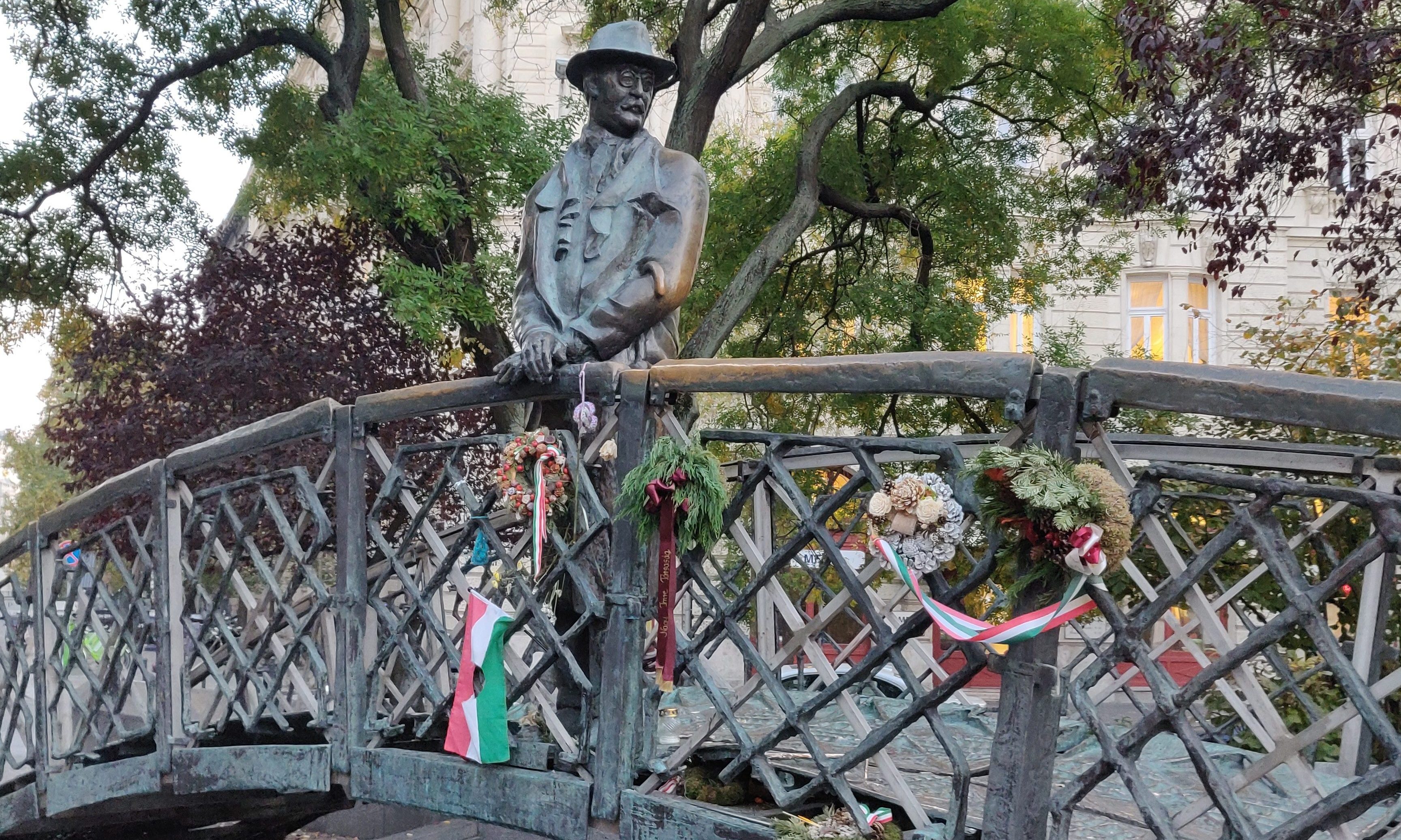
In the middle of the night in December 2018, the statue of Nagy was removed from its longtime home. Since its erection in 1996, the political narrative surrounding Nagy and the 1956 Revolution has changed substantially. From the early days of this monument, Nagy was seen as a reformer and a patriot, and the monument was only seen as offensive by staunch communists, due to its positive portrayal of this Hungarian revolutionary. Throughout the early 2000s, Nagy was portrayed as a martyr for the Hungarian people. But more recently the narrative has shifted, with Nagy portrayed as a communist collaborator, thus one of the bad actors of Hungary’s history. Once his statue was removed, the square was filled with candles and flags, as some mourned the loss in quiet protest to Hungary’s changing historical narrative.
The removal of the monument is even more poignant when considering the alliance between Orbán and Putin, who has reinstated multiple Soviet symbols over the years, such as the national anthem. The removal of this anti-Soviet figure can be seen as an attempt to make Hungary a more palatable ally for Russia.
The former home of the Nagy monument will be returned to how it looked during the interwar period, a nod once again to the era controlled by Miklós Horthy. The square will reinstall a monument to the victims of Hungary’s 1919 Red Terror, which was first unveiled in 1934 by Horthy. This move and many of the narrative shifts made by Orbán’s regime through changes to the Budapest landscape hearken back to Hungary’s right-wing authoritarian past during the 24 years in which Horthy served as head of state. In this way, we can see Nagy go from martyr to communist collaborator and Horthy go from disgraced politician to exceptional statesman. With this rewrite of Hungary’s past, Orbán is able to better make the case for the continuation of this false yet politically convenient narrative—that of a strong, right-wing, authoritarian government in Hungary.
The evolving changes to places like Budapest’s Szabadság Tér are indicative of a larger problem for Hungary. With more than 500 Hungarian news outlets currently controlled by Orbán and his friends and increasing limitations on academic freedom in Hungary, the fight to control Hungary’s national narrative has never been more important, and so far, Hungary’s right wing and far-right have been winning.
It’s noteworthy that Orbán and U.S. President Donald Trump openly admire each other—Orbán recently campaigned with the slogan “Make Hungary Great Again”—and that Orbán is a hero to many U.S. Religious Right and nationalist leaders for his promotion of Christian nationalism within the European framework, together with policies that enforce “traditional” views of sex, gender, and family. There is tremendous power in shaping the historical narrative and culture of a society, which is why a similar kind of memory politics has been and remains at the core of right-wing movements in the U.S.—from the ongoing defense of the “lost cause” myth of the Confederacy to the Christian nationalism of political operatives like David Barton and David Lane to the shameless partisan propagandizing of Dinesh D’Souza.
As changes to Budapest’s Freedom Square become increasingly common, the struggle for a narrative victory becomes more and more apparent. As the saying goes, “History is written by the victors.” But in this case, it is being written by those who have not yet won completely, but are playing for keeps.




